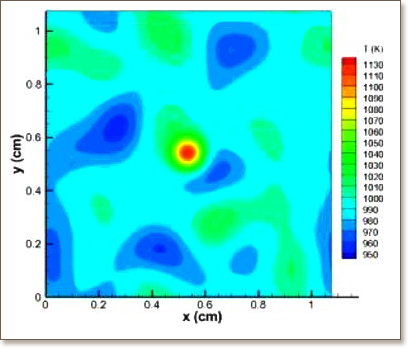

P. Pal, M. Valorani, P. G. Arias, H. G. Im, M. S. Wooldridge, P. P. Ciottoli,
Proceedings of the Combustion Institute 36 (3), 37053716, (2017)

Auto-ignition characteristics of compositionally homogeneous reactant mixtures in the presence of thermal non-uniformities and turbulent velocity fluctuations were computationally investigated. The main objectives were to quantify the observed ignition characteristics and numerically validate the theory of the turbulent ignition regime diagram recently proposed by Im et al. 2015 [29] that provides a framework to predict ignition behavior a priori based on the thermo-chemical properties of the reactant mixture and initial flow and scalar field conditions. Ignition regimes were classified into three categories: weak (where deflagration is the dominant mode of fuel consumption), reaction-dominant strong, and mixing-dominant strong (where volumetric ignition is the dominant mode of fuel consumption). Two-dimensional (2D) direct numerical simulations (DNS) of auto-ignition in a lean syngas/air mixture with uniform mixture composition at high-pressure, low-temperature conditions were performed in a fixed volume. The initial conditions considered two-dimensional isotropic velocity spectrums, temperature fluctuations and localized thermal hot spots. A number of parametric test cases, by varying the characteristic turbulent Damköhler and Reynolds numbers, were investigated. The evolution of the auto-ignition phenomena, pressure rise, and heat release rate were analyzed. In addition, combustion mode analysis based on front propagation speed and computational singular perturbation (CSP) was applied to characterize the auto-ignition phenomena. All results supported that the observed ignition behaviors were consistent with the expected ignition regimes predicted by the theory of the regime diagram. This work provides new high-fidelity data on syngas ignition characteristics over a broad range of conditions and demonstrates that the regime diagram serves as a predictive guidance in the understanding of various physical and chemical mechanisms controlling auto-ignition in thermally inhomogeneous and compositionally homogeneous turbulent reacting flows.